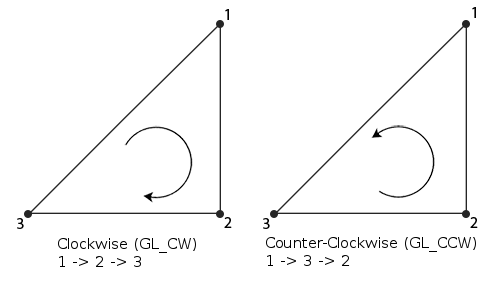Face Culling: Difference between revisions
Full face culling article, minus picture of winding. |
→Winding order: Better description of vertex order. More discussion of tessellation consequences. |
||
| Line 5: | Line 5: | ||
== Winding order == | == Winding order == | ||
When the user issues a [[Drawing Command]], the vertices processed by the [[Rendering Pipeline]] are processed in the order provided by [[Vertex Specification]]. The [[Geometry Shader]] can alter the order, but even then, the vertices created by each GS invocation are ordered relative to the other vertices. The [[Tessellation Evaluation Shader]] can directly control the order of the vertices in the tessellated patch [[#Tessellation|using special options]]. | |||
When vertices are broken down into [[Primitive]]s during [[Primitive Assembly]], the order of the vertices relative to the others in the primitive is noted. The order of the vertices in a triangle, when combined with their visual orientation, can be used to determine whether the triangle is being seen from the "front" or the "back" side. | |||
This is | This is determined by the winding order of the triangle. Given an ordering of the triangle's three vertices, a triangle can appear to have a clockwise winding or counter-clockwise winding. Clockwise means that the three vertices, in order, rotate clockwise around the triangle's center. Counter-clockwise means that the three vertices, in order, rotate counter-clockwise around the triangle's center. | ||
[[File:Winding order.png]] | [[File:Winding order.png]] | ||
| Line 20: | Line 20: | ||
The [[Fragment Shader]] gets a built-in input value saying whether the fragment was generated by the triangle's front face (this will always be true for non-triangular primitives). | The [[Fragment Shader]] gets a built-in input value saying whether the fragment was generated by the triangle's front face (this will always be true for non-triangular primitives). | ||
=== Tessellation === | |||
{{main|Tessellation Winding Order}} | |||
The winding order of the vertices generated during [[Tessellation]] is controlled by the [[Tessellation Evaluation Shader]]. It is a layout option specified by the TES, rather than a runtime value. The winding order is specified in terms of the direction: {{code|cw}} and {{code|ccw}}. Which is considered "front" is still defined by {{apifunc|glFrontFace}}. | |||
== Culling == | == Culling == | ||
Revision as of 04:37, 4 February 2015
Triangle primitives after all transformation steps have a particular facing. This is defined by the order of the three vertices that make up the triangle, as well as their apparent order on-screen. Triangles can be discarded based on their apparent facing, a process known as Face Culling.
Winding order
When the user issues a Drawing Command, the vertices processed by the Rendering Pipeline are processed in the order provided by Vertex Specification. The Geometry Shader can alter the order, but even then, the vertices created by each GS invocation are ordered relative to the other vertices. The Tessellation Evaluation Shader can directly control the order of the vertices in the tessellated patch using special options.
When vertices are broken down into Primitives during Primitive Assembly, the order of the vertices relative to the others in the primitive is noted. The order of the vertices in a triangle, when combined with their visual orientation, can be used to determine whether the triangle is being seen from the "front" or the "back" side.
This is determined by the winding order of the triangle. Given an ordering of the triangle's three vertices, a triangle can appear to have a clockwise winding or counter-clockwise winding. Clockwise means that the three vertices, in order, rotate clockwise around the triangle's center. Counter-clockwise means that the three vertices, in order, rotate counter-clockwise around the triangle's center.
Which side is considered the "front" side is controlled by this function:
This is global state. mode may be GL_CW or GL_CCW, which mean clockwise or counter-clockwise is front, respectively. On a freshly created OpenGL Context, the default front face is GL_CCW.
The Fragment Shader gets a built-in input value saying whether the fragment was generated by the triangle's front face (this will always be true for non-triangular primitives).
Tessellation
The winding order of the vertices generated during Tessellation is controlled by the Tessellation Evaluation Shader. It is a layout option specified by the TES, rather than a runtime value. The winding order is specified in terms of the direction: cw and ccw. Which is considered "front" is still defined by glFrontFace.
Culling
The primary use of setting the front facing of a triangle is to allow the culling of the front or back facing triangles.
Consider a cube; this is made of 12 triangles, but 6 of them will be facing in the opposite direction from the other 6. Unless the cube is transparent, 6 of the triangles will always be covered up by the other 6. Indeed, depending on the projection, more than 6 triangles could be covered (imagine a cube that is very close to the camera, since the front face is huge).
Face culling allows non-visible triangles of closed surfaces to be culled before expensive Rasterization and Fragment Shader operations.
To activate face culling, GL_CULL_FACE must first be enabled with glEnable. By default, face culling is disabled. To select which side will be culled, use the following function:
mode can be set to GL_FRONT, GL_BACK, or GL_FRONT_AND_BACK. The latter will cull all triangles. This is different from glEnable(GL_RASTERIZER_DISCARD), as the latter will shut off all Primitives, while culling both faces will only cull triangles (since only they have faces).
By default, GL_BACK is the face to be culled.
